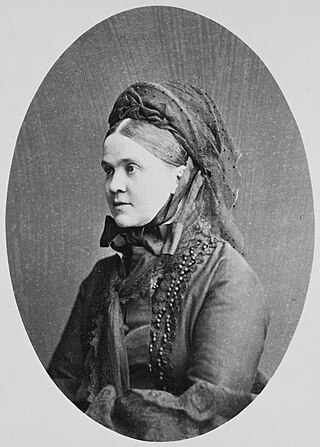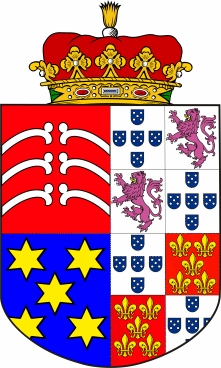
Afonso V, known by the sobriquet the African, was King of Portugal from 1438 until his death in 1481, with a brief interruption in 1477. His sobriquet refers to his military conquests in Northern Africa.

The Liberal Wars, also known as the War of the Two Brothers and the Portuguese Civil War, was a war between liberal constitutionalists and conservative traditionalists in Portugal over royal succession that lasted from 1828 to 1834. Embroiled parties included the Kingdom of Portugal, Portuguese rebels, the United Kingdom, France, the Catholic Church, and Spain.

Dona Maria II "the Educator" or "the Good Mother", was Queen of Portugal from 1826 to 1828, and again from 1834 to 1853. Her supporters considered her to be the rightful queen also during the period between her two reigns.

The Most Serene House of Braganza, also known as the Brigantine dynasty, is a dynasty of emperors, kings, princes, and dukes of Portuguese origin which reigned in Europe and the Americas.

Doña Carlota Joaquina Teresa Cayetana of Spain was Queen of Portugal and Brazil as the wife of King Dom John VI. She was the daughter of King Don Charles IV of Spain and Maria Luisa of Parma.
Prince of Beira is a title traditionally granted to the heir apparent to the throne of Portugal. The title's original use that it be granted on the eldest daughter of the reigning monarch of Portugal. Tied with the title of Prince of Beira, is Duke of Barcelos, as heir to the Duke of Braganza and Prince of Brazil. The title's name has its origins in the Beira province in central Portugal.
Infante, also anglicised as "infant" or translated as "prince", is the title and rank given in the Iberian kingdoms of Spain and Portugal to the sons and daughters (infantas) of the king, regardless of age, sometimes with the exception of the heir apparent or heir presumptive to the throne who usually bears a unique princely or ducal title. A woman married to a male infante was accorded the title of infanta if the marriage was dynastically approved, although since 1987 this is no longer automatically the case in Spain. Husbands of born infantas did not obtain the title of infante through marriage, although they were occasionally elevated to the title de gracia at the sovereign's command.

The history of the kingdom of Portugal and the Algarves, from the First Treaty of San Ildefonso and the beginning of the reign of Queen Maria I in 1777, to the end of the Liberal Wars in 1834, spans a complex historical period in which several important political and military events led to the end of the absolutist regime and to the installation of a constitutional monarchy in the country.
The highest hereditary title in the Portuguese nobility. By tradition, there are a total of five royal and seven non-royal dukes in Portugal, out of 28 dukedoms that have ever been created. In the majority of cases, the title of duke was attributed to members of the high nobility, usually relatives of the Portuguese royal family, such as the second son of a monarch.

DomSebastian Gabriel de Borbón y Braganza, Infante of Portugal and Spain, was an Iberian prince of the 19th century, progenitor of the Spanish ducal lines of Hernani, Ansola, Dúrcal and Marchena, and Carlist army commander in the First Carlist War.

Adelaide of Löwenstein-Wertheim-Rosenberg was the wife of the deposed king Miguel I of Portugal. As a widow, she secured advantageous marriages for their six daughters.

The title duke of Terceira, de juro e herdade was created by decree of King Pedro IV of Portugal, on 8 November 1832. António José de Souza Manoel de Menezes Severim de Noronha, 7th Count of Vila Flor, de juro e herdade, and 1st Marquis of Vila Flor, was the first holder of the title.

Count of Linhares was a Portuguese title of nobility created by a royal decree of king John III of Portugal dated from May 13, 1532, and granted to Dom António de Noronha, 2nd son of Pedro de Menezes, 1st Marquis of Vila Real.

Marquis of Vila Real was a Portuguese title of nobility created by a royal decree, dated from 1 March 1489, by King John II of Portugal, and granted to Dom Pedro de Menezes, also known as Peter II of Menezes, 3rd Count of Vila Real.

DomJoão Afonso da Costa de Sousa de Macedo was the 2nd Count of Mesquitela and 1st Duke of Albuquerque. Born and died in Lisbon, he was son of Luís da Costa de Sousa de Macedo e Albuquerque, the 1st Count of Mesquitela and Maria Inácia de Saldanha Oliveira e Daun, from the family of Marquis of Pombal.

Count of Alcoutim was a Portuguese title of nobility, subsidiary to the one of Marquis of Vila Real, created by a royal decree, dated from November 15, 1496, by King John II of Portugal, and granted to Dom Fernando de Menezes, also known as Ferdinand II of Menezes, 2nd Marquis of Vila Real, 4th Count of Vila Real and 2nd Count of Valença.

The Portuguese nobility was a social class enshrined in the laws of the Kingdom of Portugal with specific privileges, prerogatives, obligations and regulations. The nobility ranked immediately after royalty and was itself subdivided into a number of subcategories which included the titled nobility and nobility of blood at the top and civic nobility at the bottom, encompassing a small, but not insignificant proportion of Portugal's citizenry.

The Pantheon of the House of Braganza, also known as the Pantheon of the Braganzas, is the final resting place for many of the members of the House of Braganza, located in the Monastery of São Vicente de Fora in the Alfama district of Lisbon, Portugal. The pantheon's burials have included Portuguese monarchs, Brazilian monarchs, a Romanian monarch, queen consorts of Portugal, and notable Infantes of Portugal, among others.

D. Leonor de Almeida Portugal, 4th Marquise of Alorna, 7th Countess of Assumar was a Portuguese noblewoman, painter, and poet. Commonly known by her nickname, Alcipe, the Marquise was a prime figure in the Portuguese Neoclassic a proto-Romantic literary scene, while still a follower of Neoclassicism when it came to painting.



















